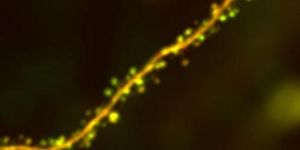B-cell Lymphoma Develops After MPN JAK1/2 Therapy
Janus kinase (JAK1/2) inhibitors have been useful in treating myeloproliferative neoplasms (MPN) since the pathway was first recognized to be critical to malignancy development in the 1990s. A new article published this month in the journal Blood illuminates a new concern for aggressive B-cell lymphoma development in myelofibrosis patients treated therapeutically with a JAK1/2 inhibitor.
The JAK pathway, in basic cellular biology terms, is part of a signaling cascade that facilitates efficient and effective communication between cells during development, in maintenance of homeostasis, and in immunity. The pathway involves a transmembrane protein and associated JAK proteins to convey a message or signal for the cell to produce a response. Initially, a ligand or growth factor binds to the extracellular portion of the transmembrane protein which signals JAK to begin activating within the intracellular matrix. The signal is maintained through a signal transducer of activation of transcription (STAT) pathway which allows the message to enter the cell nucleus and affect transcription and translation, resulting in a defined response to that original signal/message. This occurs through a cascade of multiple cellular and chemical changes that are fairly straightforward; JAK tyrosine kinases are associated with transmembrane protein receptor subunits on the cytoplasmic side of the phospholipid bilayer. The JAKs phosphorylate each other and subsequently recruit and phosphorylate other targets like the STAT proteins. Phosphorylation activates the STATs and they are allowed to enter the nucleus with the help of importin
While the pathway is relatively simple, its mechanism in cancer is less well understood because of the interactions with other pathways and signals which affect transcription at the same time. In mutagenesis, those differing effects complicate our understanding and therefore, our ability to theorize all outcomes or consequences.
The researchers in the aforementioned article have found unforeseen links to consequences in myelofibrosis patients after treatments used to inhibit JAK1/2 signaling actions in mutated cells. STAT1 is a tumor suppressor but in cases of JAK2 driven conditions, research shows the level of activated STAT1 affects the phenotype of that condition. According to the Blood article, “…results indicate that JAK1/2 inhibitor-associated lymphomas occur with increased frequency, have uniform clinic-pathological features and arise from a B-cell clone which already existed during the phase of MPN.” They evaluated Stat1 -/- mice with initial MPN and found that the course of disease paralleled what was found in the patient cases of MPN with subsequent aggressive B-cell lymphoma development after similar JAK1/2 inhibitor therapy. The decreasing presence of MPN through therapy somehow increased the evidence and manifestation of B-cell malignancy when a B-cell clone is present at the time of early state MPN. The authors felt that further study on the etiology of aggressive lymphoma in the presence of MPN would be helpful to determine if these arise from a single clone or are independent and unconnected mutations.
Sources: Blood, Annual Review of Medicine, Journal of Cell Science,









